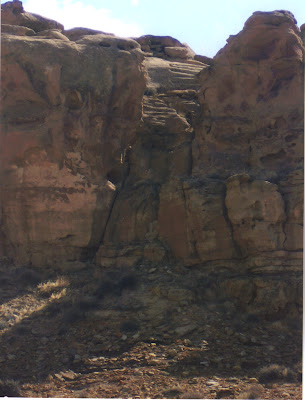Along that line of thought, we took a trip to northern New Mexico and southern Colorado. The scenery was and is spectacular…and some of the places we explored were just exceptional.
Chaco Culture National Historical Park is one of those exceptional places! Note the extra designation on the sign at the entrance to the park. This is one of only 8 manmade UNESCO World Heritage Sites in the USA.
This 33,978 acre National Park in northwestern New Mexico is about as off the beaten path as can be found in the USA. Created as a National Monument in 1907, a superintendant wasn’t named for the Park until 1923. The ‘favored’ and safest access route, as recommended by the National Park Service, includes 8 miles of paved and 13 miles of unpaved road.
This place seems almost haunted… As per UNESCO, “Chaco is an example of a prehistoric or protohistoric culture that is remarkable for its monumental public and ceremonial buildings and its distinctive architecture.” Chaco Canyon was a major center of the Pueblo culture between the years of 850 and 1250.
Chaco is an amazing place! There are many multi-storied public buildings and ceremonial structures in the park. The Chacoan people combined pre-planned architectural designs, astronomical alignments, geometry, landscaping and engineering to create this spectacular place…even 1000 years later!
The Chaco culture involved a very complex constellation of towns surrounded by satillite villages and linked by a road network. The circular kivas shown above are thought to have what might be essentially a religious role. They are regularly scattered throughout the various Chaco towns or ‘great houses’.
The stone work is absolutely fantastic! Laurie and I were fixated by the quality of the workmanship…
Using masonry methods unique at that time, the Chacoans built ‘Great Houses’, multiple stories high that contained hundreds of rooms. Construction of some of these buildings or ‘houses’ spanned decades and perhaps even centuries.
This wall is mind-boggling in it’s complexity and design!
There is a long list of great houses occupying the park. These include such names as Pueblo Bonito, Una Vida, Penasco Blanco, Hungo Pavi, Chetro Ketl and Pueblo Alto. These structures were often orientated to solar, lunar and cardinal directions. Lines of sight between the great houses allowed for better communications. Astronomical markers, communications features, water control devices and formal earthen mounds surround the great houses. The entire area is still sacred to the Chacoan’s descendants…today’s Navajo and Hopi Indians.
Since the 1930’s, Navajo Indians have been employed by the Park Service to maintain and repair the stonework. These jobs have been passed on from father to son in many cases.
From 1250 until the 1700’s, this area was practically uninhabited until Navajo Indians came into the area. The climate of Chaco Canyon 1,000 years ago was about the same as it is in the park today. Annual rainfall totals only 8 or 9 inches. The Chacoans constructed water control features such as dams, canals and headgates for farming in the high desert.
Chaco Canyon’s great houses were built at an elevation of 6,200 feet. The growing season is very short. Temperatures can vary by 60 degrees in a single day. Yet, for reasons that will probably remain unknown, the decision was made to build a complex community or civilization in this place.
At it’s peak, Chaco became the ceremonial, administrative and economic center of the San Juan Basin. Dozens of great houses in Chaco Canyon were connected by roads to more than 150 great houses throughout the region.
Many questions remain… Some believe that Chaco is really an impressive example of ‘public architecture’ that were meant to impress the people and were only used to share ceremonies, traditions, knowledge and perhaps, commerce. There are ‘rooms’ within the “great houses” that have no windows or doors that have never been explained…
An astonishing volume and variety of material was imported to Chaco Canyon. These materials included roughly 200,000 wooden beams used for the construction of the great houses. Most of them were whole trunks of Ponderosa Pines that had to come from the distant Chuska Mountains and Mount Taylor.
The first aerial photographs of Chaco and it’s structures were taken in 1929 by Charles Lindbergh’s wife, Anne Morrow Lindbergh.
This is the ‘Jackson Stairway’ leading up and out of the canyon from Chetro Ketl. When Chacoan roads came to a cliff or mesa, they will often go straight up with stairs carved into the rock…and then continue on top with the original alignment.
One amazing feature of Chaco Culture is the extensive system of finely engineered roads, both in the canyon and extending to outlying locations within the San Juan Basin and beyond. These roads are wide, straight and well built. Inside the canyon they average about 15 feet in width but the ones leading to outlying great houses tend to be twice that wide. Again, there is some argument that these roads were more ceremonial or symbolic than practical. We’ll never know for sure.
This is a great place to visit! Unfortunately, attendance at the park is down significantly. Whether the economy is to blame or it’s just a change in American’s attitude toward history and what's interesting to do on vacation, it is a fact. In 1997, attendance peaked at the Chaco Culture National Historical Park, with 113,336 visitors. Last year, there were only 34,226 visitors…about level with attendance back in 1959.
So, let’s hit the road! Make Chaco Canyon and it’s National Historical Park a destination when exploring the southwest… For more information, go to http://en.wikipedia.org/wiki/Chaco_Culture_National_Historical_Park and also check out http://www.nps.gov/chcu/index.htm.
Just click on any photo to enlarge it…
Thanks for visiting!
Take Care, Big Daddy Dave








No comments:
Post a Comment